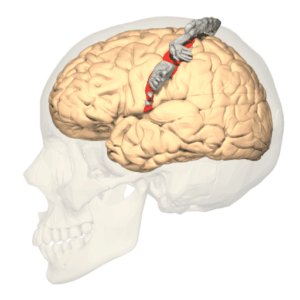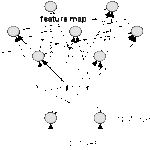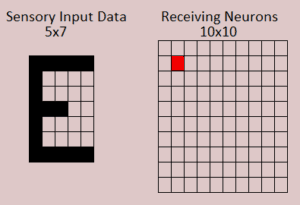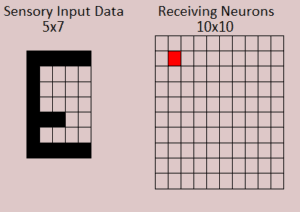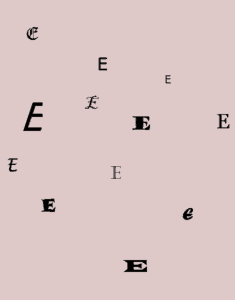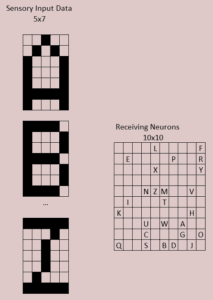Cortical maps are developed in the brain by neural processing of experience, especially timely experience. The word map implies that there is a closeness and connectivity among the physical layout of the neurons which accords with the physical layout of the external input. However, the cortical maps often have their layouts distorted according to importance or another meaningful rule.
These links allow you to jump to specific interests on this page:
- Layers of Neurons. Act together. They simplify with every group action
- Critical Learning Period. There is a particular sequence of learning
- Blank Slate. Must we learn everything or are we born with certain ideas?
Sensory Maps
Body in the Brain
For someone new to cognitive science, the phrase “maps in the brain” deserves some explanation. Let’s get concrete and use the first and most famous brain map. Neural maps of bodily parts was discovered by Wilder Penfield in the 1930s. Figure 9.1 shows the mapping between cortical neurons and bodily sensations. They were reported by his pateints when Penfield electrically stimulated neurons along the central gyrus (the protrusion before deep indentation, the central sulcus, of the cortex’s surface). Penfield and his associates separated the neurons into two maps postcentral gyrus (towards the rear of the brain) which receives bodily sensations and precentral gyrus (closer to the front of the brain) which controls the body’s muscles.
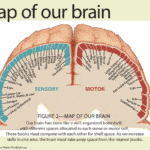
Penfield, in preparation for performing surgery on epileptics, used an electrical probe to stimulate brain areas, looking for the least disruptive path. He discovered that, when he touched particular areas of their brain, his patients reported having physical sensations. He found that the hand and fingers have a dedicated swath of neurons across the top surface of the cortex. If the probe touched this region, his patients reported having a sensation in the hand and fingers. A similar mapping could be identified for all bodily features. The number of neurons devoted to the area of our body is directly related to the sensitivity we have in that area.
The correspondence of cortical neuron areas to features of the physical world is a cortical map. It is distorted in showing the relative sizes of the body, not by physical size but by their relative sensitivity. For instance, the neural area reserved for sensation of the hand is much larger than that used for the thigh.
Further examination of this boundary area between the parietal and frontal lobes at the crown of our head, central sulcus) reveals that, while the rearward side contains the map of the bodily sensations, on the frontal side lies a similar map corresponding to the body’s muscularity, responsible for movement and action.
The arrangement of bodily parts in Figure 9.1 and Figure 9.2 is called the homunculus, Latin for little man. In philosophy and other discussions, the wod homunculus is used derisively, mocking the notion that a little independent man is directing us and our actions. That is not the connotation of homunculus here. The homunculus across the bridge of our brain is the manifestation of common genetic material sharpened by unique personal experiences. The homunculus of a newly blind person learning Braille, of an aspiring violinist, and of a recent amputee will change. They will still have cortical sensory and movement mappings but the relative sizes of the components will alter to reflect their new experience patterns.
In Genetic Effects, the pathways and areas of the cortex dedicated to particular senses were highlighted. Neuroscientists have discovered neural areas in the occipital lobe mapped for visual information. There are numerous visual maps, representing different stages of data extraction—edge detection, location, movement, color, and so forth. Similarly, the temporal lobe has auditory maps, which extend from vibration detection to sound units (phonemes) to meaning units (morphemes).
Taste and smell are handled by an earlier mechanism, the olfactory bulb, which does not dedicate as much neural processing to data extraction, and its output thus has a more immediate, less modulated effect on us.
Layer of Neurons
In the discussion on the neural threshold, we focused on the action of a single input pattern. Now let’s consider a set of inputs processed through a single layer of receiving neurons. First it will be the letter E, followed by the English alphabet.
Hebb’s Learning Law and Induction
Although there is no doubt that our brains use sensory maps, the exact mechanism by which sensory input causes and uses maps is not as firmly established. Despite the immense complexity of the brain’s neural mass, with the increasing refinement of neurological tools (our most accurate imaging tool, function magnetic resonance imaging (fMRI), summarizes the action of several million neurons at its finest resolution), significant advances have been made in the unraveling of this mystery.
The central neural learning rule was proposed by Donald Hebb in 1948:
When an axon of cell A is near enough to excite cell B and repeatedly or persistently takes part in firing it, some growth process or a metabolic change takes place in one or both cells such that A’s efficiency, as one of the cells firing B, is increased.
The repeated action of Hebb’s Learning Law results in a connection between sets of input values regularly firing a specific neuron in the receiving layer. In subsequent years, observational and experimental evidence have confirmed and refined Hebb’s fundamental insight.
Kohonen Self-Organizing Maps
How can neural networks learn physical maps without being us being born with knowledge of such maps?
Teuvo Kohonen introduced a useful simplification to model the interconnection pattern discovered in the cortex. The Kohonen model has the following characteristics:
- Automatically assigns incoming data into categories. It develops categories through its own experience, rather than by a comparison with given categories.
- Its categories are arranged by association and by frequency.
- Categories are stored in two parts—in the winning neuron and in the weights of the interconnections from the input neurons to the winning neuron.
- The connection weights reflect the efficiency of the connection, only a portion of the axon output potential is transferred across the synaptic gap to the receiving neuron.. They are a manifestation of learning. In cortical neurons.
All connections start with an undetermined (random) efficiency. This accords well with the initial setup of the brain, before any experience is gained.
In Figure 9.3, we see that after training, an inputted E settles into always sending that pattern of axon signals to the neuron in the second row, the second column, which has developed synaptic efficiency to each inputting pattern neuron, such that it fires its axon in response.
Using the network trained to recognize the alphabet (described below), a malformed E (as in Figure 9.4) is presented to the network. Even though the input pattern is somewhat different from the letter E, the combination of the sensory pattern and the developed efficiencies if the receiving neurons is such that the same neuron is fired as when a standard E was received. This despite the differences between the patterns.
The Self-Organized Map (SOM) neural network assigns this malformed E to the E category. Is there any other evidence that this occurs?
Yes, we categorize despite differences all the time. Consider Figure 9.5. Among these many styled symbols, we easily recognize most them as Es. The casual explanation is that these forms have features we associate with Es. A more precise explanation is that the novel pattern may (or may not) surmount our individual Almost Gate that leads out of the winning E neuron to downstream use of the pattern.
As mentioned, the network was randomly exposed to all the letters in the English alphabet. All letters can all be represented in the 5×7 sensory array. After repeated exposure, each input pattern becomes associated with a different neuron in the output layer (Figure 9.6). An automatic categorization has occurred, without oversight. In the artificial SOM, the assignment occurred because of calculations. In the human cortex, the axon electrical potentials and the synapse’s chemical characteristics result in the assignment of the winning neuron and the concomitant alteration of synaptic efficiencies which result in mental maps.
When a sensory neuron sends its signal into the receiving layer, the interconnections between the receiving neurons excite its closest neighbors and inhibit more distance ones. With repeated exposure of the input patterns, a winning neuron in the receiving layer gradually emerges. Figure 9.6 displays the mapping of the 26 letters of the alphabet to separate winning neurons in the receiving layer. Although Figure 9.6 doesn’t show it, all 35 of the input neurons have settled on the same weighting (synaptic efficiencies) to all 100 of the receiving neurons. It is the pattern of neurons in the input which results in the identification of the winning neuron.
This means that novel patterns, non-alphabetic inputs, may be categorized as letters or assigned to a non-letter carrying neuron in the receiving layer. And, in either case, the novel pattern will affect the set of synaptic weights connecting the input layer and the receiving layer.
Finally, we should not overlook that learning by self-organization into categories takes place by similarity (induction), not by deduction. For example, the closeness in similarity (features) of the current letter to letters you trained on leads to identification of the letter.
Critical Learning Period
Another point that bears on the origin of mental maps arises in the consideration of the critical learning period and what happens when the necessary experience is not available during the critical period. Let’s consider the acquisition of language. If a person does not hear spoken language by the age of 12 (because of deafness or in more stark cases of living among animals as a feral child), it will never be learned. If the silence is broken at the age of 8 or so, some language can be learned, but proficiency will never be gained. In a less extreme form, we see this staging in learning a foreign language. If we do not start learning it until our teens, despite the potential for mastering vocabulary and syntax, the chance to develop a native-sounding accent is gone, Klawans (p 56-72).
It’s important to distinguish two distinct roles that cortical neurons handle by separate neurobiological factors:
- First, they self-organize in local groups, based on which they categorize their input, that implicitly performs abstraction. The critical learning period is initiated by an increases in GABA.
- Second, some neurons carry the output of the local group and deliver it to a relatively distant area of the cortex for further processing. Myelin on axon sheaths finalizes the critical learning period.
The onset of the critical period depends on the availability of GABA, the brain’s main inhibitory transmitter. GABA becomes abundant in the visual cortex at about the usual time of the sensitive period. If GABA is increased in a mouse’s visual cortex shortly after birth, the sensitive period starts sooner than normal. If the cortex is deprived of GABA, the sensitive period does not occur at all, and odd experiences have no effect of the visual cortex.
Our development of categories is at its peak when the inhibitory transmitter is most abundant in the region of the cortex learning. If we do not form the categories during the sensitive period, the categories never develop to the sharpness that normal experience gives. The sensitive periods for all human senses is not known with precision. They are only detected by failure. Details are not profuse, but the existence of the sensitive period and its biological component is not in doubt.
During the critical learning period, our neurons lay down the categories which henceforth will organize the modular area will use. A novel pattern is more likely ignored or shoved into an existing category than it will be create a new category.
The transmission of the locally determined categories to other regions of the brain is controlled by the formation of a myelin sheath on axons that connect the regions. Martin Schwab is quoted by R. Douglas Fields in The Other Brain (p 231):Oligodendrocytes … as they myelinate axons, the critical period for that circuit draws to a close.
Another feature of myelination is that it occurs in various areas of the brain over a period of many years. Fields describes it (p 282).
… myelin spreads from the back of the collar to the front of the head—from vision which is developed very early in infancy, to sounds and body control, completing in our mid-20s in the most forward parts of the frontal lobe.
In coarse terms, learning can be broken down into three stages:
- Very open to experience. GABA levels are high and myelin has not yet been completed connecting local neural groups to distant modules which are connected, albeit loosely to the local group. Development of maps by frequency, association, coincidence of location or time. Learning a language is such a process, although it’s not sensory, but of a higher order of abstraction. There are sound, meaning, and organizational components to be learned.
- If the maps are not developed by the end of this stage, the person will never learn the skill that everyone else has. GABA levels subside resulting in steady synaptic efficiencies. Also about the same time, new connections are no longer being myelinated to distant modules.
- Use of skill. The maps supporting the skill are used easily; however, maps only change with difficulty. GABA levels are too low to easily change synaptic efficiencies in the local group. Myelin sheaths are completed and shuttle the relatively stable local categories to other areas of the brain for use.
The learning stages are controlled by a two physiological process – the infusion of GABA affecting synaptic changes on novel input and the fixing of connections between relative distant cortical regions by myelin coating axons allowing that the signal travels up to 100× faster than it would in an uncoated axon.
Genetics is now seen as not being a static endowment of brain characteristics, but as a vehicle affecting how we learn and response to our experiences. Perhaps a bit surprising, experiences that do not take place during the critical stage will result in holes in one’s capabilities, despite having the requisite physical tools. This is as true for vision as for later learned behaviors. If one does not have positive role models during younger years when norms of expectations are formed, that person thereafter views experiences without fundamental norms that society expects. That is not a death knell to good behaviors, but an indication that the person will either act poorly or substitute higher intellectual skills to cover more basic behaviors into acceptable behaviors.
Blank Slate. Transcendental Ideas
A long-standing debate in philosophy focuses on human knowledge. Is all knowledge derived from experience or are we born with existing knowledge? The question has various guises. Three are body-mind, a posteriori or a priori, and blank slate versus transcendental. In the visual system, it has been found that certain groups of neurons react preferentially to lines in the visual field, others to involuntary movements, still others to directional movements. In that limited fashion, akin to Lego building blocks, we have a priori structures hard-wired in the brain.
For example, in vision we are born capable of resolving (Kalat p 166, discussing Hubel and Wiesel’s discoveries)- horizontal lines
- vertical lines
- edge detection
These hard-wired structures are very general and quite primitive building blocks–a very small step up from a blank slate. They are transcendental, innate ideas but they do not relate to morality nor are they advanced concepts. We are born with common building blocks to assemble our picture of the world, but we do not start with a specific moral code or knowledge of experiential data. It places us much nearer to a blank slate than universal concepts.
Next, let’s discuss the development of semantic maps, maps of meaning.
Related topics:
Kohonen Network Basics
External Flux, Internal Stability
Partial Pattern Completion
Learning Critical Period
